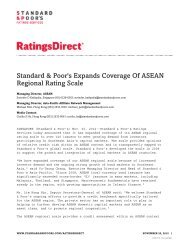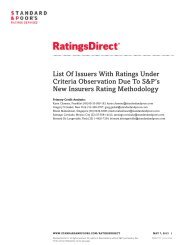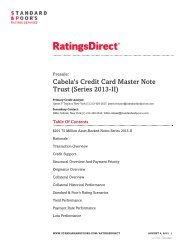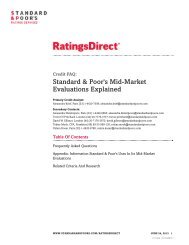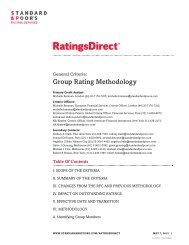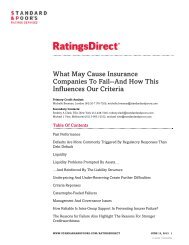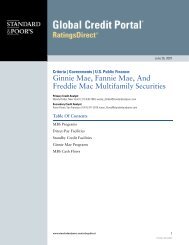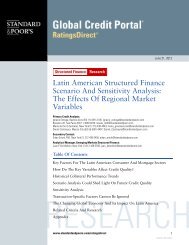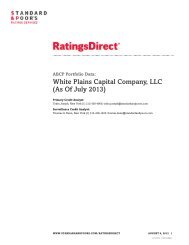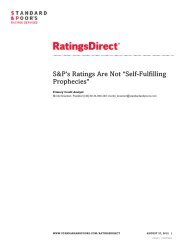Principles Of Credit Ratings - Standard & Poor's
Principles Of Credit Ratings - Standard & Poor's
Principles Of Credit Ratings - Standard & Poor's
Create successful ePaper yourself
Turn your PDF publications into a flip-book with our unique Google optimized e-Paper software.
General Criteria: <strong>Principles</strong> <strong>Of</strong> <strong>Credit</strong> <strong>Ratings</strong>• Operational and administrative risks; and• Counterparty risk.7. The analytic framework for corporate and government ratings includes three key areas:• <strong>Credit</strong>worthiness before external support;• External support; and• Analysis of specific instruments.IMPACT ON OUTSTANDING RATINGS8. This criteria update does not cause changes to any outstanding ratings.EFFECTIVE DATE AND TRANSITION9. These criteria are effective immediately for all new and outstanding ratings.FUNDAMENTAL PRINCIPLES OF STRUCTURED FINANCE RATINGS ANDCRITERIA<strong>Credit</strong> Quality <strong>Of</strong> The Securitized Assets10. In most securitization transactions, the first key step in analyzing the credit quality of the securitized assets isdetermining the amount of credit support necessary, in our opinion, to maintain a rating at the 'AAA' level. Thatdetermination is equivalent to estimating the amount of losses that the assets would suffer under conditions ofextreme stress. The estimation can include reference to historical studies of the subject asset class or, when suchstudies are not available and as we deem appropriate, comparison or benchmarking relative to asset classes forwhich such studies do exist.11. For some asset classes, the estimation may proceed in stages: We might separately estimate asset default frequenciesand loss severities under extreme stress conditions and then combine those components to form the overall lossestimate. Similarly, for some asset classes, the estimation may use generalizations based on historical studies, such asthe notion that losses under extreme stress conditions can be estimated as a multiple of expected losses, with themultiple potentially varying for different asset classes.12. For some asset classes, <strong>Standard</strong> & <strong>Poor's</strong> defines an archetypical asset pool and uses it as a comparison benchmarkfor gauging the estimated losses under extreme stress for pools underlying actual transactions in such asset classes.In some cases, the maximum rating for the highest rated security may be below 'AAA' based on our assessment offactors such as country risk, or transfer and convertibility risk, and we would adjust the analysis accordingly.13. In many securitization transactions, a key step in analyzing the credit quality of the securitized assets is estimatingthe level of expected losses. The level of expected losses generally corresponds to the amount of credit enhancementassociated with the 'B' rating level. Estimation of expected losses generally uses the recent performance of similarassets as a guide. The estimation may include adjustments based on our assessment of current trends, as well asevolving market practices.14. Interpolation is one of the methods we may use when we analyze the amount of credit enhancement associated withwww.standardandpoors.com/ratingsdirect 3916650 | 300323561
General Criteria: <strong>Principles</strong> <strong>Of</strong> <strong>Credit</strong> <strong>Ratings</strong>the rating levels between 'AAA' and 'B' for transactions in certain asset classes. For other asset classes, we createspecific benchmarks, such as coverage multiples or simulated default rates, within a mathematical simulation model.15. Our view on the credit quality of a pool of assets may change over time. The performance of the pool may divergefrom expectations and that divergence may reveal credit strengths or weakness that were not previously apparent.Through our surveillance processes, we reassess the credit quality of the pool based on certain information regardingthe observed performance and other factors we deem relevant.Legal And Regulatory Risks16. <strong>Standard</strong> & <strong>Poor's</strong> assessment of legal and regulatory risks focuses primarily on the degree to which a securitizationstructure isolates the securitized assets from the bankruptcy or insolvency risk of entities that participate in thetransaction. Typically, our analysis focuses on the entity or entities that originated and owned the assets before thesecuritization, although the creditworthiness of other entities also may be relevant. A true sale of the subject assetsfrom the originator/seller to a special purpose entity (SPE) is one method commonly used by an arranger seeking toachieve asset isolation in a securitization. From a legal perspective, a true sale is generally understood to result in theassets ceasing to be part of the seller's bankruptcy or insolvency estate. There may also be other legal mechanisms,apart from true sale, that may achieve analogous comfort. SPEs are entities that typically are used in a securitizationtransaction to "house" the assets that will back the payment obligations usually represented by the securities issuedby the SPE. In the context of our analysis, <strong>Standard</strong> & <strong>Poor's</strong> forms an opinion about the insolvency remoteness ofan SPE based on our evaluation of the specific facts and circumstances that we view as applicable to a particulartransaction. Among other things, the analysis considers whether the separate legal identity of the SPE would berespected by bankruptcy courts or bodies charged with similar functions. In addition, we assess the presence offeatures intended to minimize the likelihood that the SPE itself becomes the subject of bankruptcy.Payment Structure And Cash Flow Mechanics17. The rating analysis for structured finance typically includes an analysis of payment structure and cash flowmechanics. This portion of the analysis may involve both assessing the documentation for a security and testing thecash flows using quantitative models. In both cases, the objective is to assess whether the cash flow from thesecuritized assets would be sufficient, at the applicable rating levels, to make timely payments of interest andultimate payment of principal to the related securities, after taking account of available credit enhancement andallowing for transaction expenses, such as servicing and trustee fees. The analysis may encompass diverse features ofthe payment structure and cash flow mechanics, ranging from the basic payment priorities inherent in a deal (i.e.,the subordination hierarchy of tranches) to the impact of performance covenants (i.e., so-called "triggers") that mayoperate as switches that materially change the distribution priorities if they are breached. Finally, for securities thatembody support facilities from third parties, such as insurance policies, guarantees, bank credit and liquidityfacilities, and derivatives instruments, the analysis focuses on the payment mechanics for those obligations.Operational And Administrative Risks18. The analysis of operational and administrative risks is another part of the structured finance rating analysis. Thispart of the analysis focuses on key transaction parties to determine whether they are capable of managing asecuritization over its life. Key transaction parties may include a transaction's servicer or manager, the asset managerof a collateralized debt obligation (CDO), the trustee, the paying agent, and any other transaction party; herein wecollectively refer to these parties as servicers.19. In securitizations involving many asset classes, the analysis focuses on evaluating a servicer's or manager's ability to<strong>Standard</strong> & Poors | <strong>Ratings</strong>Direct on the Global <strong>Credit</strong> Portal | February 16, 2011 4916650 | 300323561
General Criteria: <strong>Principles</strong> <strong>Of</strong> <strong>Credit</strong> <strong>Ratings</strong>perform its duties, such as receiving timely payments, pursuing collection efforts on delinquent assets, foreclosing onand liquidating collateral, tracking cash receipts and disbursements, and providing timely and accurate investorreports. For transactions that involve revenue-producing assets (e.g., commercial property), the analysis may include,as we deem appropriate, assessment of certain incremental risks associated with managing the assets. For activelymanaged portfolios, the analysis considers the asset manager's capabilities and past performance as an assetmanager.20. The analysis of operational and administrative risks generally considers the possibility that a servicer may becomeunable or unwilling to perform its duties during the life of the transaction. In that vein, the analysis may considerboth the potential for hiring a substitute or successor servicer and any arrangements that provide for a designatedbackup servicer. That portion of the analysis would typically consider the sufficiency of the servicing fee to attract asubstitute, the seniority of the fee in the payment priorities, and the availability of substitute servicers.Counterparty Risk21. The fifth part of the rating analysis is the analysis of counterparty risk. That analysis focuses on third-partyobligations to either hold assets (including cash) or make financial payments that may affect the creditworthiness ofstructured finance instruments. Examples of counterparty risks include exposures to institutions that maintain keyaccounts and exposures to the providers of derivative contracts such as interest rate swaps and currency swaps. Thecounterparty risk analysis considers both the type of dependency and the rating of the counterparty for eachcounterparty relationship in a transaction.FUNDAMENTAL PRINCIPLES OF CORPORATE AND GOVERNMENTRATINGS AND CRITERIA<strong>Credit</strong>worthiness Before External Support22. The most important step in analyzing the creditworthiness of a corporate or governmental obligor is gauging theresources available to it for fulfilling its commitments relative to the size and timing of those commitments.Assessing an obligor's resources for fulfilling its financial commitments is primarily a forward-looking exercise. Itmay entail estimating or projecting future income and cash flows. It may include consideration of economicconditions, the regulatory environment, and economic projections and forecasts. For business entities, future incomeand cash flows may come primarily from ongoing operations or investments. For governmental entities, income andcash flows may come primarily from taxes. In some cases, other resources, including liquid assets or, in the case of asovereign obligor, the ability to print currency, may be relevant.23. The assessment of resources considers both the expected level of future income and cash flows and their potentialvariability. For all types of obligors, the assessment includes both qualitative and quantitative factors.24. The quantitative side of the analysis focuses primarily on financial analysis and may include an evaluation of anobligor's accounting principles and practices.25. For business entities, key financial indicators generally include profitability, leverage, cash flow adequacy, liquidity,and financial flexibility. For financial institutions and insurers, other critical factors may include asset quality,reserves for losses, asset-liability management, and capital adequacy. <strong>Of</strong>f-balance sheet items, such as securitizations,derivative exposures, leases, and pension liabilities, may also be part of the quantitative analysis. Cash flow analysisand liquidity assume heightened significance for firms with speculative-grade ratings ('BB+' and lower).www.standardandpoors.com/ratingsdirect 5916650 | 300323561
General Criteria: <strong>Principles</strong> <strong>Of</strong> <strong>Credit</strong> <strong>Ratings</strong>26. For governmental entities, the quantitative factors we assess are different from the factors we assess for businessentities; they generally include both economic factors and budgetary and financial performance, as well as additionalitems for sovereign obligors. The economic side of the analysis typically encompasses demographics, wealth, andgrowth prospects. The budgetary and financial side generally includes budget reserves, external liquidity, andstructural budget performance. For sovereign obligors, additional quantitative factors that may, in our view, berelevant to our analysis include fiscal policy flexibility, monetary policy flexibility, international investment position,and contingent liabilities associated with potential support for the financial sector.27. Trends over time and peer comparisons may be part of the quantitative analysis for both business and governmentalentities.28. On the qualitative side, the analysis of business entities focuses on various factors, including: country risk, industrycharacteristics, and entity-specific factors. We intend for our analysis of the country risk factor to capture ourassessment of the financial and operating environment that applies broadly to businesses in a particular country,including a country's physical, legal, and financial infrastructure. Historically, this assessment has often operated toconstrain the ratings of business entities in countries that have high country risk.29. Industry characteristics typically encompass growth prospects, volatility, and technological change, as well as thedegree and nature of competition. Broadly speaking, the lower the industry risk, the higher the potential creditrating for an obligor in that sector. The analysis also considers certain entity-specific factors that we believe candistinguish an individual obligor from its peers. These may include diversification of the obligor's products andservices as well as risk concentrations, particularly for a financial institution. Obligor-specific factors also mayinclude operational effectiveness, overall competitive position, strategy, governance, financial policies, riskmanagement practices, and risk tolerance.30. Qualitative factors for governmental entities are somewhat different from the factors for business entities. Ouranalysis may encompass political risks, including the effectiveness and predictability of policymaking andinstitutions and the transparency of processes and data and the accountability of institutions. In addition, forsovereign obligors, consideration of political risks may include an assessment of the potential for war, revolution, orother security-related events to affect creditworthiness. Other qualitative considerations that may be part of ananalysis of a governmental obligor include revenue forecasting, expenditure control, long-term capital planning, debtmanagement, and contingency planning. Finally, the assessment of a governmental obligor focuses on the potentialthat the obligor might default even when it has the resources to meet its financial commitments.External Support31. In addition to our assessment of an obligor's stand-alone creditworthiness, <strong>Standard</strong> & <strong>Poor's</strong> analysis considers thelikelihood and potential amount of external support (or influence) that could enhance (or diminish) the obligor'screditworthiness. When an obligor's creditors have the benefit of contractual support, such as a guarantee from ahigher-rated guarantor, the analysis may assign the guarantor's rating to the supported issue or issuer. However, thisoccurs only when the guarantee satisfies stringent conditions and guarantees full and timely payment of theunderlying obligation.32. Apart from formal guarantees, the analysis considers the potential for other support from affiliated business entities,governments, and multilateral institutions. For affiliated business entities, the analysis considers both the degree ofstrategic importance of subsidiaries or affiliates to determine the likelihood and degree of support by a strongerparent and - the parent's capacity to provide such support.<strong>Standard</strong> & Poors | <strong>Ratings</strong>Direct on the Global <strong>Credit</strong> Portal | February 16, 2011 6916650 | 300323561
General Criteria: <strong>Principles</strong> <strong>Of</strong> <strong>Credit</strong> <strong>Ratings</strong>33. For governmental support, the analysis considers the potential for various forms of support. For example, theanalysis considers potential support for government-related entities (GREs), such as certain public utilities,transportation systems, and financial companies. The analysis of a GRE considers the role that the entity plays andthe nature of its links to its government. A similar line of analysis applies to the potential for extraordinarygovernment support to banks that, in our view, have systemic importance in a national economy. In the case of asovereign obligor, the analysis considers the potential for support from multilateral institutions (e.g., theInternational Monetary Fund [IMF]).34. The assessment of potential external support generally does not include the benefits that an obligor receives merelyby being part of a system or framework. We consider those benefits in the assessment of industry characteristics orotherwise in the analysis of stand-alone creditworthiness. For example, the stand-alone analysis of a bank includesconsideration of benefits that we believe it may receive from supervision within its regulatory framework and fromaccess to low-cost borrowings from its central bank. Likewise, the analysis of governments (e.g., a school district)may include an evaluation of system support provided by a higher level entity (e.g., a city or state).35. In some cases, external support can have a negative influence on an entity's creditworthiness. For example, this canhappen when a weaker parent company drains cash flows or assets from a stronger subsidiary through dividends orin other ways. Similarly, a sovereign government can be a negative factor for a company's creditworthiness if itintervenes by withdrawing resources or limiting the company's financial flexibility.Notching And Analysis <strong>Of</strong> Specific Instruments36. The analysis of specific instruments includes consideration of priorities within an obligor's capital structure and thepotential effects of collateral and recovery estimates in the event of the obligor's default. The analysis may applynotching to instruments that rank above or below their obligor's senior, unsecured debt. For example, subordinateddebt would generally receive a rating below the senior debt rating. Conversely, secured debt may receive a ratingabove the unsecured debt rating.37. Notching also applies to the structural subordination of debt issued by operating subsidiaries or holding companiesthat are part of an enterprise viewed as a single economic entity. For example, the debt of a holding company maybe rated lower than the debt of its subsidiaries that have the enterprise's assets and cash flows. We extend thenotching approach to analyzing the creditworthiness of instruments involving payment priority. For example, wewould generally rate preferred stock and so-called hybrid capital instruments lower than senior debt to indicate thatpayment could be deferred.RELATED CRITERIA AND RESEARCH• Methodology: <strong>Credit</strong> Stability Criteria, published May 3, 2010• Understanding <strong>Standard</strong> & <strong>Poor's</strong> Rating Definitions, published June 3, 2009• <strong>Principles</strong> <strong>Of</strong> Corporate And Government <strong>Ratings</strong>, published June 26, 2007• <strong>Principles</strong>-Based Rating Methodology For Global Structured Finance Securities, published May 29, 2007.These criteria represent the specific application of fundamental principles that define credit risk and ratingsopinions. Their use is determined by issuer- or issue-specific attributes as well as <strong>Standard</strong> & <strong>Poor's</strong> <strong>Ratings</strong>Services' assessment of the credit and, if applicable, structural risks for a given issuer or issue rating. Methodologyand assumptions may change from time to time as a result of market and economic conditions, issuer- orwww.standardandpoors.com/ratingsdirect 7916650 | 300323561
General Criteria: <strong>Principles</strong> <strong>Of</strong> <strong>Credit</strong> <strong>Ratings</strong>issue-specific factors, or new empirical evidence that would affect our credit judgment.<strong>Standard</strong> & Poors | <strong>Ratings</strong>Direct on the Global <strong>Credit</strong> Portal | February 16, 2011 8916650 | 300323561
Copyright © 2012 by <strong>Standard</strong> & <strong>Poor's</strong> Financial Services LLC. All rights reserved.No content (including ratings, credit-related analyses and data, model, software or other application or output therefrom) or any part thereof (Content) may be modified,reverse engineered, reproduced or distributed in any form by any means, or stored in a database or retrieval system, without the prior written permission of <strong>Standard</strong> & <strong>Poor's</strong>Financial Services LLC or its affiliates (collectively, S&P). The Content shall not be used for any unlawful or unauthorized purposes. S&P and any third-party providers, as wellas their directors, officers, shareholders, employees or agents (collectively S&P Parties) do not guarantee the accuracy, completeness, timeliness or availability of theContent. S&P Parties are not responsible for any errors or omissions (negligent or otherwise), regardless of the cause, for the results obtained from the use of the Content, orfor the security or maintenance of any data input by the user. The Content is provided on an "as is" basis. S&P PARTIES DISCLAIM ANY AND ALL EXPRESS OR IMPLIEDWARRANTIES, INCLUDING, BUT NOT LIMITED TO, ANY WARRANTIES OF MERCHANTABILITY OR FITNESS FOR A PARTICULAR PURPOSE OR USE, FREEDOM FROM BUGS,SOFTWARE ERRORS OR DEFECTS, THAT THE CONTENT'S FUNCTIONING WILL BE UNINTERRUPTED, OR THAT THE CONTENT WILL OPERATE WITH ANY SOFTWARE ORHARDWARE CONFIGURATION. In no event shall S&P Parties be liable to any party for any direct, indirect, incidental, exemplary, compensatory, punitive, special orconsequential damages, costs, expenses, legal fees, or losses (including, without limitation, lost income or lost profits and opportunity costs or losses caused by negligence)in connection with any use of the Content even if advised of the possibility of such damages.<strong>Credit</strong>-related and other analyses, including ratings, and statements in the Content are statements of opinion as of the date they are expressed and not statements of fact.S&P's opinions, analyses, and rating acknowledgment decisions (described below) are not recommendations to purchase, hold, or sell any securities or to make anyinvestment decisions, and do not address the suitability of any security. S&P assumes no obligation to update the Content following publication in any form or format. TheContent should not be relied on and is not a substitute for the skill, judgment and experience of the user, its management, employees, advisors and/or clients when makinginvestment and other business decisions. S&P does not act as a fiduciary or an investment advisor except where registered as such. While S&P has obtained information fromsources it believes to be reliable, S&P does not perform an audit and undertakes no duty of due diligence or independent verification of any information it receives.To the extent that regulatory authorities allow a rating agency to acknowledge in one jurisdiction a rating issued in another jurisdiction for certain regulatory purposes, S&Preserves the right to assign, withdraw, or suspend such acknowledgement at any time and in its sole discretion. S&P Parties disclaim any duty whatsoever arising out of theassignment, withdrawal, or suspension of an acknowledgment as well as any liability for any damage alleged to have been suffered on account thereof.S&P keeps certain activities of its business units separate from each other in order to preserve the independence and objectivity of their respective activities. As a result,certain business units of S&P may have information that is not available to other S&P business units. S&P has established policies and procedures to maintain theconfidentiality of certain nonpublic information received in connection with each analytical process.S&P may receive compensation for its ratings and certain analyses, normally from issuers or underwriters of securities or from obligors. S&P reserves the right to disseminateits opinions and analyses. S&P's public ratings and analyses are made available on its Web sites, www.standardandpoors.com (free of charge), and www.ratingsdirect.comand www.globalcreditportal.com (subscription), and may be distributed through other means, including via S&P publications and third-party redistributors. Additionalinformation about our ratings fees is available at www.standardandpoors.com/usratingsfees.www.standardandpoors.com/ratingsdirect 9916650 | 300323561




